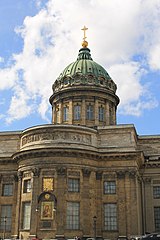
Saint Isaac's Cathedral or Isaakievskiy Sobor is a large architectural landmark cathedral that currently functions as a museum with occasional church services in Saint Petersburg, Russia. It is dedicated to Saint Isaac of Dalmatia, a patron saint of Peter the Great, who had been born on the feast day of that saint. It was originally built as a cathedral but was turned into a museum by the Soviet government in 1931 and has remained a museum ever since, with church services held in a side chapel since the 1990s. In 2017, the Governor of Saint Petersburg offered to transfer the cathedral back to the Russian Orthodox Church, but this was not accomplished due to the protests of St Petersburg citizens opposing the offer.

The Peter and Paul Cathedral is a Russian Orthodox cathedral located inside the Peter and Paul Fortress in St. Petersburg, Russia. It is the first and oldest landmark in St. Petersburg, built between 1712 and 1733 on Hare Island along the Neva River. Both the cathedral and the fortress were originally built under Peter the Great and designed by Domenico Trezzini. The cathedral's bell tower is the world's tallest Orthodox bell tower. Since the belfry is not standalone, but an integral part of the main building, the cathedral is sometimes considered the highest Orthodox Church in the world. There is another Cathedral of Saints Peter and Paul Church in St. Petersburg, located in Petergof.
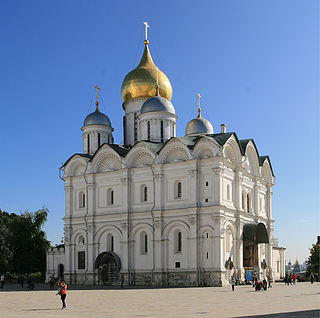
The Cathedral of the Archangel is a Russian Orthodox church dedicated to the Archangel Michael. It is located in Cathedral Square of the Moscow Kremlin in Russia between the Great Kremlin Palace and the Ivan the Great Bell Tower. It was the main necropolis of the tsars of Russia until the relocation of the capital to St. Petersburg.

Our Lady of Kazan, also called Mother of God of Kazan, is a holy icon of the highest stature within the Russian Orthodox Church, representing the Virgin Mary as the protector and patroness of the city of Kazan, and a palladium of all of Russia and Rus', known as the Holy Protectress of Russia. As is the case for any holy entity under a Patriarchate in communion within the greater Eastern Orthodox Church, it is venerated by all Orthodox faithful.

Vladimir Lukich Borovikovsky was a Russian artist of Ukrainian Cossack origin. He served at the court of Catherine the Great and dominated portraiture in Russia at the turn of the 19th century.

The Alexander Nevsky Cathedral of Tallinn is an Eastern Orthodox cathedral in central Tallinn, Estonia. It was built in 1894–1900, when the country was part of the former Russian Empire. The cathedral is the city's largest cupola church. The late Patriarch Alexy II of Moscow (1929–2008) started his priestly ministry in the cathedral. It is the primary cathedral of the semi-autonomous Estonian Orthodox Church of the Moscow Patriarchate.
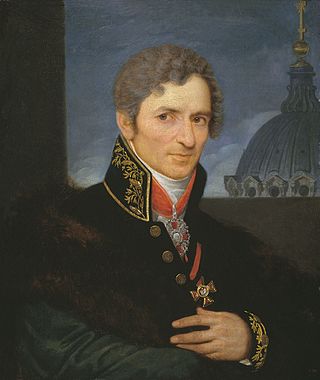
Andrey (Andrei) Nikiforovich Voronikhin was a Russian architect and painter. As a representative of classicism he was also one of the founders of the monumental Russian Empire style. Born a serf of the Stroganov family, he is best known for his work on Kazan Cathedral in Saint Petersburg.

Eastern Orthodox church architecture constitutes a distinct, recognizable family of styles among church architectures. These styles share a cluster of fundamental similarities, having been influenced by the common legacy of Byzantine architecture from the Eastern Roman Empire. Some of the styles have become associated with the particular traditions of one specific autocephalous Eastern Orthodox patriarchate, whereas others are more widely used within the Eastern Orthodox Church.
The appearance of Saint Petersburg includes long, straight boulevards, vast spaces, gardens and parks, decorative wrought-iron fences, monuments and decorative sculptures. The Neva River itself, together with its many canals and their granite embankments and bridges help to give the city its particular ambience.

St. Michael's Cathedral is a cathedral of the Orthodox Church in America Diocese of Alaska, at Lincoln and Maksoutoff Streets in Sitka, Alaska. The earliest Orthodox cathedral in the New World, it was built in the nineteenth century, when Alaska was under the control of Russia, though this structure burned down in 1966. After 1872, the cathedral came under the control of the Diocese of Alaska. It had been a National Historic Landmark since 1962, notable as an important legacy of Russian influence in North America and Southeast Alaska in particular.
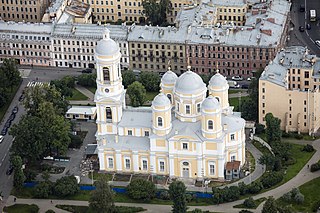
The Prince St. Vladimir's Cathedral, formally the Cathedral of St. Equal to the Apostles Prince Vladimir is a Russian Orthodox cathedral in Saint Petersburg, Russia. It is located on Blokhin Street in the Petrogradsky District of the city across the Malaya Neva from the Spit of Vasilevsky Island, in close proximity to the Sportivnaya metro station.

The Alexander Nevsky Cathedral is a Russian Orthodox cathedral church located at 12 Rue Daru in the 8th arrondissement of Paris. The closest métro station is Courcelles .

The Metropolitan Cathedral of the Holy and Equal-to-the-Apostles Mary Magdalene is a Polish Orthodox cathedral, located at al. Solidarności 52 in Warsaw.

Lazarevskoe Cemetery is a historic cemetery in the centre of Saint Petersburg, and the oldest surviving cemetery in the city. It is part of the Alexander Nevsky Lavra, and is one of four cemeteries in the complex. Since 1932 it has been part of the State Museum of Urban Sculpture, which refers to it as the Necropolis of the Eighteenth Century. It covers 0.7 hectares.

The Holy Trinity Cathedral of the Alexander Nevsky Lavra is a Russian Orthodox cathedral in Saint Petersburg. It is in the Diocese of Saint Petersburg and part of the Alexander Nevsky Lavra, where it is the cathedral church of the monastery complex.
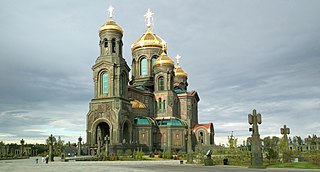
The Main Cathedral of the Russian Armed Forces is a lavish Russian Orthodox Patriarchal cathedral in honour of the Resurrection of Christ and "dedicated to the 75th anniversary of victory in the Great Patriotic War, as well as the military feats of the Russian people in all wars", built in the Patriot Park in the Odintsovsky District, Moscow Oblast.
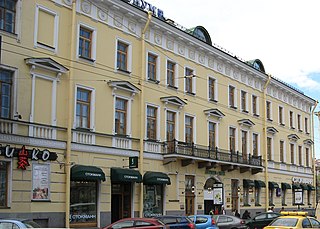
Kazan Cathedral House, also widely known as the house of the clergy of the Kazan Cathedral, is a historic building in Saint Petersburg, Russia. The building was built in 1813-1817 in the style of Russian Neoclassicism. Architects—Vasily Stasov, Andrey Voronikhin. Before the Russian Revolution, the house belonged to the clergy of the Kazan Cathedral . Location: St. Petersburg, Nevsky Prospect, 25 & Kazanskaya street, 1. Regional object of cultural heritage.













